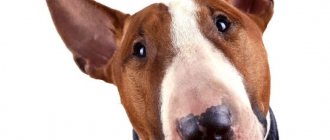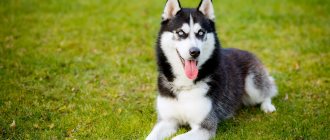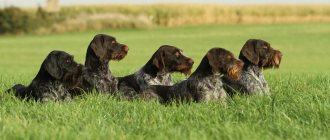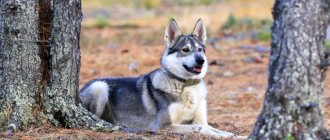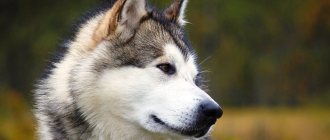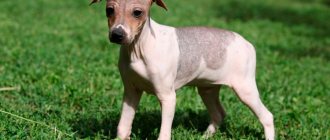- Pekingese
Raising a dog is about developing correct behavior.
This is the basis for successful training. Training is a set of activities aimed at training specific teams. It is necessary to start raising a puppy from the very first days of his appearance in the house. If you work with your pets from a very early age, then you are on the right track. Pekingese were bred in China for the imperial family. Today they are excellent companion dogs who greet everyone they meet with dignity and grace.
- Country of Origin : China
- Height at withers : 15-25 cm
- Weight : male 3.2-5.0 kg, female 3.6-5.4 kg
- Lifespan : 12-15 years
- Use : companion dog
- Other names : Pekingese spaniel, Pekingese palace dog, pocket dog
Description
The Pekingese breed has a massive head, and its height is greater than its width, with a wide and flat skull. The sharp transition from the forehead to the muzzle does not make the dog ugly, especially since it has large, dark and round eyes that are framed by black eyelids. The lips fit tightly, and the nose has a large, flat lobe, which is black in color. Heart-shaped, drooping ears with long hair at the leading edge lie close to the cheekbones.
The dog has a short and thick neck, and the front part of the body is much more powerful than the back. The body shows clearly convex ribs and a straight back, with the back of the body narrower than the front. Wide chest and short but powerful limbs. Flat paws slightly turned to the sides. Long, thick hair on a high-set tail. The tail is thrown behind the back, but thanks to the thick fur it hangs over one side. Around the neck and on the shoulders, abundant straight hair forms a mane. The same hair is on the back of the limbs and on the ears. There is a thick undercoat on the body.
According to the standards, Pekingese can have any color, both solid and with markings - the exception is chocolate-colored coat and albinism. If the dog has marks, then they should have a symmetrical arrangement. The height of the dog at the withers is a minimum of 15 cm, a maximum of 25 cm. Depending on the size, the Pekingese can weigh from 2.5 to 5.5 kg.
Pekingese training in Moscow and the region.
Pekingese training classes are conducted both on-site and at home. The trainer travels to all districts of Moscow: Zao, Szao, Sao, Svao, Vao, Yuvao, Yuao, Yuzao, as well as to cities near Moscow.
Dog training is based on correct relationships, on contact between owner and dog, so dog training should begin as early as possible. The most successful age for education, taking into account imprinting (imprinting), is at 2.5 - 3 months of age .
The center’s staff works individually, selecting the training course that is right for you and your dog, without unnecessary commands or exercises..
History of the breed
The Pekingese breed is very ancient. It was bred in China, in Beijing (hence the name) initially for the imperial court. Chinese breeders did not set any tasks for the Pekingese, other than to be a companion and decoration of the palace interior. He was never required to chase game, guard the owner's property, transport sleighs and carts, or catch rodents. No, God forbid! Only pillows, sofas, imperial knees and a staff of servants to boot. The result was a dog with the appearance of a lion and the corresponding manners. Ancient Legend: According to a version of an ancient Chinese legend, the Pekingese is the fruit of love between a fearless lion and a mischievous monkey. For the sake of his beloved, the king of beasts sacrificed his title and power. A Buddhist monk reduced it in size, and the animals got married. The child of love inherited a brave and majestic disposition from his father, and a sweet, comical appearance from his mother.
No one in China, under penalty of death, could own a Pekingese. It was a breed exclusively of the family of His Imperial Majesty. Interesting fact: the Pekingese has a trail of special selectivity. In ancient China, this dog was endowed with the property of being the spiritual protector of the imperial family. Therefore, when the owner left the earthly world, his Pekingese was sent after him - to protect him in the other world. Dramatic changes in the life of the Pekingese came when the Chinese Empire collapsed. 5 unusual dogs came to England in 1860 as war trophies. They fell in love, liked them, enchanted them, and already in 1893 they were presented at the English dog show. After 7 years, Germany had its own nurseries that bred Pekingese, and in 1909, the first American Pekingese Club appeared. This breed reached Russia only after the Second World War, where it gained wide popularity in the 70s of the last century.
Maintenance and care
Pekingese coat care requires not so much knowledge as consistency and up to 15 minutes a day (at most). Always monitor the condition of your pet's coat. Brush the animal every day to remove dirt picked up on the street and collect loose hair. Water procedures are needed as the wool becomes dirty. Usually it is enough to bathe your dog once a month, using a special shampoo for dogs. Claws, eyes, ears and the fold under the nose also require care - they are wiped from time to time with wet wipes.
The Pekingese should be fed only dry food or only natural food. Choose based on your financial capabilities and availability of free time. Dry food is more profitable in terms of time, while feeding natural food will certainly save the owner a penny. If you choose dry feeding for your dog, then buy high-quality super-premium food. If you choose natural food, you just need to understand the ingredients needed for nutrition.
How to care for a Pekingese?
It is worth saying that the Pekingese values comfort and tranquility most of all . These dogs do not like fuss, chaos and disorder. They are calm, full of dignity and ready to be a friendly friend to their owners. Caring for a Pekingese at home requires daily attention and time for general grooming.
Owners of thick coats, consisting of guard hairs and soft undercoat, constantly need combing , otherwise tangles and their subsequent cutting cannot be avoided. Dogs of this breed are compared to small lions because of their thick mane on their heads. This hairstyle requires constant attention and periodic haircuts for hygienic purposes.
Dogs that are being prepared for participation in exhibitions are almost not cut, with the exception of the groin area and paw pads.
Among the specific features of the breed, the special structure of the muzzle is noted - it is very flattened.
In this regard, the Pekingese has weak teeth and bulging eyes .
Important! Due to the short muzzle, the dog cannot cool the air in the nose during the hot season. Therefore, it is very important to avoid overheating the animal. It is advisable to equip your home with air conditioning.
Car transportation in hot weather should be done with the windows open, and the dog should be placed on a wet towel; you can additionally moisten the fur with water. The coolness in the room where the Pekingese lives must be maintained at any time of the year.
teeth should be constantly cleaned of tartar and brushed 1-2 times a week with toothpaste sold in pet stores. Large bulging eyes are another feature of the skull structure of this breed. They should not tear or fester . If you notice such manifestations, you need to wipe them with water or a 2% boric acid solution and contact a veterinarian , since eye diseases can lead to serious consequences, such as cataracts.
The Pekingese, although a lap dog, needs walks. Walking is important for maintaining shape and grinding claws on the asphalt. In any case, your dog's nails should be trimmed once a month, as well as any overgrown hair between the paw pads.
The condition of the auricle is checked . If odors or discharge appear, clean the ears with a cotton swab soaked in hydrogen peroxide.
Education and training
Training a Pekingese is not for the faint of heart. The breed is very stubborn and willful, so you need to be persistent when practicing commands, and also spend a little more time on training. Like many decorative Pekingese breeds, there is no point in chasing them along the entire general course. Teach your dog the most necessary commands, such as “come to me”, “near”, “fu”, “place”, “sit”, “lie down”, “give” - all well-mannered dogs should know them, since these commands are used very and very often. Having achieved your orders with one command, you can be sure that you will control your pet.
Parents can entrust the training and education of a Pekingese to a child from 8-10 years old. But be prepared, if necessary, to come to the child’s aid and suggest a way out of the situation or find a solution to the problem of the dog’s behavior. In general, it is not difficult to wean a Pekingese from picking up various crap from the floor, taking food from the hands of strangers, biting the owner’s hands, gnawing things, jumping with its paws and correcting any other problematic behavior. To make it easier to control the dog, you need to ensure that there is enough physical activity when walking, and also establish rules of behavior in the family.
Raising a Pekingese
The owner should start raising a Pekingese puppy on the first day of meeting his new pet. The child needs to clearly outline the boundaries of what is permitted and make it clear what actions will forever remain prohibited for him.
Toilet training your puppy is the first thing you need to do. Cleanliness is something that is quite difficult to achieve from these dogs. At first, while the baby is in post-vaccination quarantine and cannot be walked with him on the street, he can be allowed to relieve himself in a diaper or in a litter tray. As soon as the quarantine is over, the puppy needs to be taken outside several times a day, where he must do “all his business.” You should not expect that success will be achieved in the shortest possible time; in the first few weeks, puddles and piles on the floor in the house cannot be avoided.
Important! At the same time, the Pekingese needs to be taught to respond to his name.
In addition, dog education includes learning the rules of behavior in the house and on the street, and teaching basic commands. The Pekingese must understand what “No!” or “Ugh!” The dog should know that at home it is forbidden to bark without special reasons, chew furniture, personal belongings of the owner, and so on. It is quite difficult to achieve this from phlegmatic Pekingese, who are almost always on their own. But if the owner is patient and shows character, his efforts will yield good results.
It is extremely important to teach your Pekingese to walk on a leash. Most representatives of this breed do not like harnesses and protest with all their might against their presence on street walks. But the owner should not follow his pet’s lead and refuse safe walks. In order for the dog to quickly get used to it, you should not pull the leash too hard, much less use it as a weapon of punishment or intimidation.
Important! When raising a Pekingese, do not raise your voice at him or show aggression. Strict intonation will be quite enough for the dog to understand that he is doing something wrong.
MATING
Features of mating The physiological structure of dogs of this breed explains some difficulties during mating and childbirth. It would be correct if this is observed by a qualified specialist, a veterinarian. He will be able to control these processes and provide assistance in a timely manner. So, during mating, due to the incorrect structure of the nose, animals may experience breathing problems. In addition, a rush of blood to the back of the body can provoke a lack of oxygen in the brain. Because of this, the animal may lose consciousness. In difficult situations, short-term cardiac arrest is possible. During childbirth, females experience problems associated with the discrepancy between the size of the puppy and the size of the birth canal. A dog that has reached the age of seven to one year can be considered a sexually mature male. However, in some countries it is prohibited to allow Pekingese dogs under twelve months of age to breed. Female Pekingese are considered sexually mature from the onset of their first heat, which occurs between six and twelve months of age. But you should not postpone the first mating until too late. Since, due to the changes that have occurred in the body, the risk increases that the female will not be able to give birth on her own. In such cases, a caesarean section is performed. Gestation in Pekingese lasts about fifty to seventy days. The more babies in the litter, the sooner labor will begin.
Read Pekingese online. Day after day. | The most important rules in raising Pekingese puppies
The most important rules in raising Pekingese puppies
There are no particular difficulties in raising a Pekingese if it is purchased where it is supposed to be, that is, the puppy is initially healthy, with good heredity and a stable psyche. Raising such a puppy is a pleasure. All you have to do is get age-appropriate vaccinations on time and watch how your dog gets prettier every day.
In the meantime, while the dog’s child is sleeping, you and I will agree, especially if he has not yet been vaccinated, that the puppy should not come into contact with outdoor shoes. To do this, you will have to put up a partition in the corridor for some time, behind which all your household members will change their shoes into slippers. You should also wash your hands before interacting with the puppy.
Dogs are not lifted by their front legs, and even less so puppies: the ligaments are still very weak, and if you lift a puppy incorrectly just once, you can make him disabled for the rest of his life.
If you have small children at home, be sure to explain that the Pekingese, although very similar to a soft toy, is in fact not a toy at all. If you constantly squeeze a small Pekingese and don’t let him live in peace, then you will grow up with a twitchy, nervous and biting dog. A puppy is the same as a child, only a dog, and he must play when he himself wants it, and rest when his growing body requires it.
To establish contact with your puppy, you need to be very patient and affectionate, which in general is not difficult at all if you love your dog. And your pet will repay you with boundless love and devotion.
How to properly pick up a Pekingese puppy
In addition, the Pekingese is a very smart breed, and you will definitely see this. Dogs love to be the center of attention, understand perfectly well when their beauty is admired, and generally love the company of people.
But now your new resident has woken up. After sleep, the first thing the puppy does is empty its bladder. Usually, if the puppy has already been accustomed to the newspaper, then you will not have any problems, the conditioned reflex will take him straight to where he is supposed to, but it happens that the puppy gets confused and makes a puddle right on the floor. Do not scold him under any circumstances, take a newspaper that is intended for the toilet, place it on the puddle made by the puppy, let the newspaper become saturated with his urine, return it to its original place and show all this to the puppy. If not immediately, then after another this method will definitely work, and in about a week or ten days, when you let the puppy out of his pen, you will no longer have problems with puddles.
Until you decide that the puppy has already adapted sufficiently in your home and can be released and while he lives in some part of the apartment, visit him more often, pet him, talk to him and sometimes pick him up, but very carefully.
Pekingese loves to walk
The puppy is lifted with two hands: one hand under the chest, the second under the butt, that is, the puppy seems to be sitting on one hand. Since the puppy is quite energetic, you need to hold it so that it does not wriggle out and fall. Also, never leave the puppy alone on a chair or sofa, and if you take it with you, then before leaving, lower the Pekingese to the floor. The puppy does not have a developed sense of height at all, and he does not understand what an edge is.
But let's get back to our baby. Having done your business, you can play a little before eating. It is, of course, easier to play on an empty stomach, and in the meantime you must prepare his next portion of food. Try not to give the same food in a row.
Since puppies are mainly purchased at the age of 1.5 to 3 months, the diet of puppies of different ages is slightly different, but the main differences relate to meat. If it is raw, then it is given to the puppy separately or mixed with vegetables (vegetables begin to be added to food after 3 months). They give milk porridge (which is completely excluded after 3 months), cottage cheese is always offered, if the puppy does not refuse it himself - porridge in meat or chicken broth with finely chopped meat or chicken. The most important thing is to give all new food little by little and monitor the results.
If from the first days you do not learn to gently but persistently achieve from the puppy what is required of him, at least starting with small demands, it will subsequently be very difficult to retrain him.
While you have still learned something, the baby has had enough of playing and with the appetite that is inherent in any growing and healthy organism, having eaten, he goes back to bed. It’s not surprising: the little puppy basically just sleeps and eats; he doesn’t yet have enough strength for long games. But don’t be upset, puppies grow very quickly, and by six months your Pekingese will have reached almost its “adult size”, then it will only gain its gorgeous fur, which grows as long as our hair, so never cut your Pekingese. He will swear, that is, from a not very well-built teenager, he will gradually turn into a beautiful, harmoniously built dog.
What to feed
Having decided to have this breed of dog at home, you need to decide what to feed the Pekingese. It is advisable that the diet does not differ significantly from the foods that the previous owners fed the puppy, at least at first, until he gets used to the new conditions. In the first months, the number of meals should be six times. Gradually, by nine months, feeding should be reduced to two times. It is desirable for a small puppy’s menu to include various cereal porridges - rice, millet, buckwheat and oatmeal. Not every puppy’s body will digest milk well; it is better to stick to fermented milk products and cottage cheese. Pekingese will eat fresh vegetables and seasonal fruits, both boiled and raw, with great pleasure. Beef, lamb, pork, poultry, and rabbit meat must be the main products in a dog’s diet. Pekingese, these decorative and principled dogs, love the attention of their owners so much that they are suitable only for those people who have enough time for long walks and entertainment with their pets. Their love of comfort and curiosity can bring their owners a lot of trouble. But loyalty and constant readiness to protect their owners will not leave anyone indifferent.
Hygiene
Proper maintenance and care of the Pekingese includes compliance with all hygiene standards. This is the only way to keep your pet healthy.
How often should you bathe your Pekingese?
Many new owners have a question: is it possible to bathe a Pekingese often?
Due to exposure to detergents, the layer that is needed to protect the skin from external irritants is destroyed. The quality of the coat deteriorates, redness and inflammation appear on the skin. Therefore, you should not bathe the Pekingese often; in this case, care does not imply endless washing.
It is not recommended to bathe a puppy who is under three months old. If the dog gets dirty, remove the dirt with a wet cloth.
After walks, wash your belly and paws with clean water without shampoo. The Pekingese should be bathed completely using a special shampoo.
Bathing the entire dog is recommended no more than three times a year.
Wool
An important part of keeping and caring for representatives of this breed is taking care of the long and fluffy coat, which is prone to tangles.
Proper care is to comb it at least three times a week, otherwise the hair will mat.
The situation is even worse during seasonal molting, which occurs three times a year. At this time, fur flies everywhere, and the pet must be combed every day using a special slicker brush.
Owners of Pekingese dogs often turn to the services of groomers; even in humans, care and a beautiful, neat haircut are inseparable things. The shortened coat does not mat so much, the pet takes on a well-groomed appearance, and in the summer it does not suffer from overheating.
This is interesting! The Pekingese is a short dog; the fur on its belly is shortened. Then he doesn’t get too dirty during his daily walks.
Eyes
Due to the flattened shape of the muzzle, the eyes require careful care. They are susceptible to inflammation and mechanical injury. Therefore, you need to carefully monitor your vision.
Several times a week, wipe your eyes with a cloth moistened with clean drinking water. If your eye is inflamed, apply special drops to it, or rinse it with chamomile solution.
If the inflammation does not go away, immediately take your pet to the doctor. Eye care for dogs of this breed is very important: due to inflammation of the eyes, the pet can not only go blind, but in some cases die.
Teeth
The unusual shape of the skull means that the Pekingese breed is prone to a variety of dental problems. Therefore, an important aspect of the care and maintenance of the Pekingese breed is oral hygiene.
At the age of four, the Pekingese may begin to lose its molars. To avoid this, it is important to carefully monitor the condition of your oral cavity.
Brush your dog's teeth once a week with a toothbrush and toothpaste. The mouth should be examined for inflammation and injury.
Important! If your dog has weak teeth, dry, prepared food can cause them to become loose and fall out. Therefore, it is better to feed the Pekingese with canned food, or pour dry food with water to soak it.
Ears
The Pekingese's ears are covered with fur and dirt and wax can accumulate in them. They need careful care.
You should examine your ears once a week: there should be no excess wax, pus or dark plaque in them. Cleaning is carried out using a regular ear stick moistened with water or a special solution.
Claws
When caring for your Pekingese at home, do not forget about the length of its claws. This is a sedentary dog that doesn't run around much. Therefore, her claws are difficult to grind down. If you do not pay attention to this problem, it will soon become uncomfortable and painful for your pet to walk.
The Pekingese's nails should be trimmed once a month: using a special nail clipper, cut off the tip of the nail that gets in the way.
Nail care should be done with care; there are blood vessels and nerves at the base of the claw. During the procedure, trim the hair growing between the toes, which interferes with walking.
Dimensions: weight, height
It is unusual that the average weight of female Pikinese dogs can be slightly higher than the weight of males of this breed. Males weigh from 3.2 kg to 5.5 kg. The weight of bitches should be between 3.6-5.6 kg. The height at the withers of Pekingese is 15-25 cm. Pekingese have a massive head, but it is proportional with a wide and flat skull. The following proportion of the skull must be maintained: its width exceeds its depth by 1/5; flat forehead and cheekbones. A strongly pronounced transition from the forehead to the face of the Pekingese; the face is massive, snub-nosed, wide and slightly shortened; The black and large nose is mostly flattened and located at the level of small but expressive eyes. Wide, large and raised nostrils; small ears are heart-shaped or have poplar leaves. When the dog is calm, they hang down on both sides of the head. The front edge of the ears lies close to the cheekbones. Long hair grows on them; round, shiny eyes are larger in size and dark brown in color.
The eyelids are dry and tight; small teeth are always straight and white; a short and strong neck, the skin on it should not form folds, but fit tightly; smooth, muscular and long back; strong loin, slightly arched; Quite pronounced withers, smoothly turning into a straight line of the top. The shoulder blades, tightly pressed and slanted, should not stick out or move away from the back;
Temperament and character
Despite their compact miniature size, Pekingese have leadership abilities and quite often demonstrate them in front of their owners or other pets.
They are fearless, but their character lacks natural aggression. They are very loyal to their owners. But among the unpleasant qualities one can note some arrogance, which is not surprising given their “royal” roots, as well as rare stubbornness. Representatives of this breed are recommended to be purchased as pets by elderly and inactive people and homebodies. But such dogs are unlikely to be suitable for athletes, hunters and service dog lovers. There is no consensus on the attitude of Chinese pets towards children. It all depends on various factors, but often they are not very affectionate with younger family members, although they do not offend.
The overall picture is that Pekingese are dogs with a calm and balanced temperament. Although dogs can show “who is boss”, they can be kept with other dogs and even with representatives of cat breeds and smaller pets. After all, these dogs do not have a hunting instinct in their blood.
Yes, dogs have a rich coat, however, they cannot be kept on the street, since, despite some independence and arrogance, they can only fully grow and develop near members of their family. In this case, the animal will have a healthy psyche. The pet is always ready to defend its owner, and the size of the offender does not matter to him, even if it is a person who came as a guest. Therefore, the dog needs training, and from the very beginning of its appearance in the house.
Pekingese training
| +7 (495) 798-8858 | |
- Home News
- Photo gallery
- Vacancies
- affiliate program
- Blog
- Forum
- Contact Information
Services
Pekingese are small, furry dogs that were developed in China over 2,000 years ago. They have a good-natured and cheerful disposition, and will happily take part in all kinds of family entertainment.
Pekingese are very loyal to their owners, just like many centuries ago. They make wonderful pets, but not for families with small children. This is due to the fact that Pekingese do not like to be given little attention. They, and only they, should be the main favorites in the family and get either all or nothing. Also, Pekingese will not tolerate anything if toddlers drag them by the tail. They can also cite you for inappropriate behavior. Pekingese feel most comfortable sitting in someone's arms and being petted, because they love affection.
Training Pekingese is a rather painstaking task. You yourself don’t even have to waste energy teaching your Pekingese commands, because you need to devote a lot of time to this activity. Only in this case will you be able to get the Pekingese to carry out commands without fail.
The Pekingese will only be obedient if you gain his trust. It is important to remember that Pekingese do not tolerate criticism. As already mentioned, they feel comfortable in an apartment, provided that small children or other pets do not live with them.
Pekingese, as a rule, sleep where his “place” is, and where he likes. Commands such as “sit or lie down” are not for Pekingese dogs. You just need to come to terms with the fact that there is a creature living next to you who has a very independent character, and who needs to be loved and accepted for who he is.
When walking your Pekingese, it is best to interact with small dogs so as not to provoke a fight in different weight categories. All Pekingese feel like a big dog, so it will not be difficult for him to show his teeth even to a Caucasian Shepherd.
Today, Pekingese live in many people's apartments. In most cases, the choice is made in their favor because of their good looks. Pekingese are rightfully considered everyone's favorite, which is why they are very common throughout the world. The most important thing in training a Pekingese is to find a common language with the dog and make it trust you. Then you will have the best pet.
WalkService Pekingese training
on “Training the Pekingese”
- Andrey:
03/09/2012 at 16:42
And I taught my picinese the command to sit and does it perfectly! But he doesn’t want to fulfill the place or lie down!(
Answer
- Irina Gorshkova:
02/04/2013 at 16:09
My Morris Philip is one year and four months old, on command he gives his front and back paws, lies down, turns over his back, jumps over a stick, now we are mastering the “serve” trick, it is difficult because the dog is fat. But very smart and completely adored.
Answer
- Inna:
02/10/2013 at 23:03
I read how you manage your pet, maybe you can tell me how to teach a Pekingese to listen to commands on the street, otherwise it always runs away without a leash
Answer
- Oleg:
02/27/2013 at 19:59
Please tell me how to get your Pekingese to go to the toilet!…
Answer
- Yana:
10/13/2013 at 19:04
My doll is already 6 years old, she screams and commands her paw, sit, lie down and comes to me, and I trained her myself.
Answer
- Maria:
04/02/2017 at 06:15
How old were you when you started training a dog?
Answer
Add a comment Cancel reply
Diseases and breed defects
The Pekingese's genetic predisposition to diseases is determined by the hereditary characteristics of the breed. Congenital and hereditary diseases of such a pet can be represented by:
- cataracts, which consist in changes in the structure of the eye lens and its clouding;
- distichiasis or abnormal eyelash growth;
- inversion and inversion of the eyelid;
- dermatitis in the folds of the muzzle;
- hemolytic anemia caused by a failure of autoimmune processes;
- hypoplasia of the teeth, causing immobility of the animal;
- hypothyroidism, accompanied by an insufficient amount of thyroid hormones;
- inguinal hernia;
- pathologies of intervertebral discs;
- keratitis and kerato-conjunctivitis;
- atresia of the lacrimal ducts and lens displacement;
- progressive retinal atrophy;
- ulcerative keratitis;
- umbilical hernia.
According to veterinarians, among Pekingese there are many “heart problems” and dogs with severe respiratory pathology . Also, joint diseases and eye problems, characteristic of domestic animals from the brachycephalic group, are not uncommon.
Where to buy and what to look for
To buy a purebred and healthy animal, you need to adhere to the following recommendations:
- You need to purchase a Pekingese puppy from nurseries or from well-established, experienced breeders;
- during the selection process, it is advisable to view several litters of the breed at once in different nurseries;
- the age of the pet being sold must not be less than two months;
- before purchasing, you must find out whether deworming and vaccination have been carried out according to age;
- a prerequisite is the conclusion of an agreement that stipulates bilateral responsibility, and a clause on the possibility of returning the animal within a certain time.
Important! Experienced breeders will not guarantee that a puppy is in the “show class” until the age of six months.
It is important to remember that if you plan to purchase an exhibition animal or one participating in breeding, you must obtain a guarantee from the nursery. It is also necessary to take into account that the only official representative of the FCI in our country is the RKF .
Pekingese dog price
The cost of a puppy at breeding kennels can vary significantly depending on the class of the animal, as well as the reputation of the breeders and their location.
For example, in Krasnodar, a “show class” Pekingese puppy from the RKF kennel costs about 30-35 thousand rubles. In the capital and St. Petersburg, prices are slightly higher. An animal without documents can be purchased much cheaper, but it will be impossible to guarantee the health of such a puppy and its breed.
